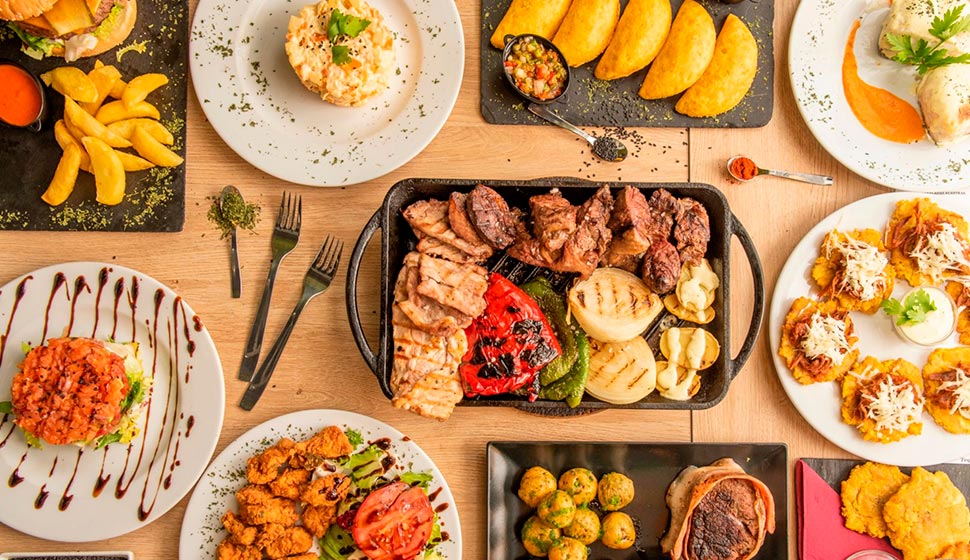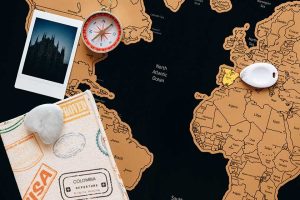
The Quest for Culinary Diversity: Island, City, Mountains
The food in Santa Marta is delicious: fresh, accessible, flavorful. But it’s also a bit monotonous, an endless parade of fried fish, grilled chicken, patacon [plantain pancake] and arroz con coco [coconut rice, which locals in their charming, final-syllable-swallowing accent call arro-co-co]. Of course the universe of fruits is vast, with mangoes, papayas, avocados, lulos, guanabana, guayaba and coconuts, but still. I’m not saying that we left town just for new food — our psychological health was another factor — but with a week and game visitor du jour, why stay in Santa Marta?
The Quest for Rondon: San Andres Part of the excitement of San Andres for me — besides rumors of warm turquoise water, of course — was its non-Colombia-ness. Sure, it’s has the brain-poaching heat and swarming motos of Santa Marta, but it springs from a completely different cultural and gastronomical bloodline. So hooray for white-sand beaches, I thought, but HUZZAH for a break from pescado frito. I gleefully and voraciously read about the specialties of the region: johnnycakes, crab and conch, and most intriguingly, a soup called rondon which features fish, pork, various yucca-like vegetables and dumplings all stewed in coconut milk. It sounded amazing. My quest for culinary variety did not start well.
We headed out eagerly from our rented house in a Raizal village, sneering at the first food we saw — the inescapable empanadas. After a fruitless (literally) ten-block search in the searing heat, we found an unpromising roadside stand, where the woman sadly informed us that she had no breakfast but, if we were desperate, she could make us hot dogs. Because what says tropical vacation more than hot dogs and teeth-chatteringly sweet instant coffee from a roadside stand at 9am? We had better luck at lunch, when a few more stands in our area opened. If by “luck” you mean something besides hot dogs, but alas, the options matched exactly the choices in Santa Marta. Grilled chicken and plantains it was. Again. By dinner, when everything was inexplicably closed — the eternal mystery of opening hours is Colombian theme — we were resigned to cooking in our rental house, whose kitchen, while stylish, lacked somewhat in the supplies department. No cutting board, for example, and pans whose handles spontaneously fell off. This echoed the general feel of the house; it was trying so hard, yet somehow missing the mark. A bar full of wine-glasses and colored up-lights, for example, but a gap under the back door three cockroaches high.
A Jacuzzi tub, but no working hot water. An edgy orange sectional in the living room, and six plastic lawn chairs. It was sad and vaguely distressing, like watching a poor woman wearing her nicest dress suddenly realize that it’s somehow — indefinably — just not quite right. For two days, I distracted my taste buds with snorkeling and diving, biding my time and surviving on scrambled eggs and arroz con pollo. Again. The underwater scene was amply distracting, with wrecks and seagrass meadows and the entire cast of Finding Nemo nibbling at my fins. I asked every single islander where I could find johnnycakes and rondon, carefully cataloguing each response as they gestured vaguely toward Sound Bay or the West View, saying, “There’s a place… It’s near the health clinic…” and fade off. On our way to rent a stylish Kawasaki side-by-side — de riguer wheels for the tourist on island exploration — we asked the taxi driver to drop us somewhere in town for johnnycakes.
Being Colombian and unable to disappoint us, he assured us he knew just the place, and left us at a restaurant with the exact same options we have every day in Santa Marta: eggs fried, scrambled, scrambled with tomatoes and onions* or “in casserole” which is just fried eggs, but in a different-shaped pan. Also, arepas and rice. Again. I’ll go ahead and skip to the end, since you clearly know where this is going. Despite a fantastic day of exploration, snorkeling, dancing in a tropical storm, and an impossibly cheesy tour of pirate Henry Morgan’s cave of treasures (yes, that Captain Morgan), no one delivered the rondon. Sure, we finally found a place that served us some mediocre crab, and conch drenched beyond recognition in garlic, but we were informed that rondon is “only available on weekends.” It reminded me of wombats, an animal we never once saw in our eight weeks in Australia, despite everyone’s claims that they were as plentiful as kangaroos, koalas and dingos. Or like Mt. Rainier, which appears on endless numbers of posters, mugs and sweatshirts yet never once appeared in the ten days we spent in the region. We even camped on the alleged mountain for five days and still saw only the inside of a cloud. In the end, on our way to the airport after profoundly mediocre pizza, our taxi driver stopped at a bakery that allegedly makes johnnycakes.
They were out, they said, but if we were willing to wait five minutes (Colombian time, of course), a fresh batch was due out soon. And so we bought our taxi driver’s patience with a couple of steaming hot and delicious johnnycakes and headed back to the mainland, convinced that rondon — like Yetis, wombats, the Loch Ness Monster, the Holy Grail and Mt. Rainier — is a ruse cooked up my locals with which to taunt tourists.
* This format for eggs — scrambled with tomatoes and onions — is called huevos pericos on the coast. Near Bogota, if you ask for perico, you get coffee with milk, which is known as cafe con leche along the coast. Perico, if you’re curious, means parakeet. And people wonder why adults are never actually fluent in a second language. Country Mice Visit the Big City: Bogota We flew that night from San Andres to Bogota on Viva Colombia, an airline that mashes up Southwest’s boarding mayhem, Spirit Air’s draconian luggage rules and Greyhound’s pricing to entertaining effect. If you find it entertaining to be calming eating a Whopper Jr. (don’t judge; it does not involve plantains) in front of the gate labelled with your flight only to discover — at the last possible moment — that it is boarding from another gate completely. Or to accidentally smuggle both a giant pocket knife and forty ounces of liquid sunscreen on board, only to endure a full police pat-down in the gangway followed by a heavy sniff-check by a German shepherd named Hielo [Ice].
In this Andean capital city, the third highest in the world, we savored the sweet, delicious feeling of blankets, and hugs that ended without that squelching noise your skin makes in humid, half-dressed climates. We marveled at how weird it was to wear closed-toed shoes (the first in months!) and sleeves. Our mouths hung open in awe at the stunning city-ness of Bogota: the sharp suits, the fashionable women, the joggers, the gorgeous street art, the wine stores, the taxi meters, the funky galleries. Everything has signs! The showers are hot! There is a child in a car seat, for heaven’s sake, not clutched under his mom’s arm on a moto! It was so familiar, so comforting, that we all teared up a bit. Of course, not everything was familiar, in that homey, estadounidense way. For example, here is a partial list of items we could have bought from the window of our bus and we crawled through traffic: brooms, selfie sticks, bootleg movies, various bread-based snacks, stuffed animals, cotton candy, board games, coloring books, lottery tickets, tamales and baggies of small fruit. Given the legendary nature of Bogota’s traffic, this is apparently how rolos complete their errands, and so very Colombian.
Also, the church at Montserrat, high above the city, upped the stakes for the Creepiest Jesus award, an award Retta has invented to accompany her obsession with the gruesomeness and Mary-o-centricity of Colombian Catholicism; the pale beneficence of mainstream-American-Protestant Jesus is apparently not compelling enough. In Bogota, I got to try ajiasco, their traditional chicken-potato-cream soup made with capers and a pungent herb called guasca; Jack wrinkled his nose and ordered a burger. And we drank hot chocolate with a hunk of cheese and cornbread that is allegedly how Bogotans stay warm in this city whose highest recorded temperature — of all time! — is 76 degrees Fahrenheit. At the airport, at the Colombian-despite-its-name Crepes and Waffles, I had a dish involving both tofu — the first I’ve seen here — and curry. Mmmmmm…. But despite the comforts, we’re not really city people and so out into the mountains we headed.
The Valley of the Sun (and apparently rain): Boyaca We traveled to the department of Boyaca (on a clearly labeled bus, by the way, which left exactly on time — wow, right?) to partake in Eric’s second-most-dreamed-of activity on this trip (after mastering the art of free-diving): climb mountains. On the first day, we did a warm-up stroll outside of Sogamosa, because the asthma-like 3000 meter (9000 feet) altitude is no joke after four months at sea-level. Our practice trail led along horse paths and rutted dirt roads through tidy, eucalyptus-lined farmland. Smug-looking cows, mustachioed men in ponchos and the omnipresent terrifying Colombian guard dogs kept us company. And because I am clearly obsessed with culinary diversity and Jack will do pretty much anything for sugar, we headed out to the Sunday postres [desserts] festival in the impossibly adorable village of Iza. The region around Iza us littered with asaderos serving up grilled meat in venues ranging from plywood stands to sprawling former-farmhouses, and fabricas de arepas [arepa factories]. It even has a section with fancy-font signs declaring the “Ruta de la Carne”; I mean, who wouldn’t fall in love with a Meat Route?
In Iza, at their postres festival, you can load up on plates of a broad variety of pudding-like desserts. Our lunch? Seven plates: a flan-like one, tres leches, arequipe [caramel], a guanabana [a kooky spiky fruit] meringue, tiramisu, lime and a kids-only one involving jello and whipped cream. And we befriended — as usual — an entire extended family of touring Colombians who marvelled at our Spanish, practiced their English, and — to the eyerolls of their tweens and the deep, deep sighs of Jack — took photos of themselves hugging our kids. Everywhere we go, regardless of climate, our un-Colombian color scheme of blond-and-blue and hilariously ungrammatic Spanish continues to entertain locals. The next morning, ready for A Real Hike, we met our guide in the square of yet another delicious colonial town, in the shadow of an enormous basilica completely out of sync with the tiny, remote village in which it is located. This requirement for a guide is also very Colombian. It doesn’t generally bother me, since I have yet to see a single trail sign nor map, but I do occasionally wonder if it is to boost employment or because there are still undesirable elements when you leave town. Maria, however, was not visibly carrying a machete — our first guide without one — as she led us out of Mongui, in the rain, and into the paramo.
The paramo is an ecosystem characterized by tropical tundra, if you can wrap your head around that concept. Basically, the above-treeline, below-snowline (3000-5000 meters in altitude) space between the Tropic of Cancer and the Tropic of Capricorn, primarily along the spine of the Andes. It looks like Alaska mated with Anza Borrego — short flowers, boggy mud, and hairy cactus-y looking plants, some up to 200 years old. Up we headed, out of town, through the Puerta de la Gloria [the Door to Glory], a lung-busting, muddy hike in sleet-like rain. Eric and I were in heaven. But the kids? Not so much. They soldiered through, being Good Sports, for a good 2.5 hours until they decreed, “No more.” The lines of hills marched on in front of us, cloud-shrouded and tempting, but we are finally — finally — learning to listen to our children’s needs on this trip. (This skill is aided by Retta’s technique of fake-coughing, “ Bike tour,” when we start pressuring them to go just a little further, or do just a little more. ) The moment we turned around, the sun came out, the rainbows sparkled, the flowers shown and the kids sang and horsed around. While teaching me about native plants (to which I was politely yet absently nodding), Maria showed me an herb that locals boil with milk and make a pungent cheese. I perked up. “Where can I buy some?” I asked, to which she ruefully shook her head. “It’s something we just make at home,” she told me. “You can’t buy it in stores.” I mean, come on, people. Stop taunting me.
We dried out our toes in a fantastic little restaurant in Mongui where I finally — finally! — got a true culinary adventure. First, nabos, which are startlingly purple roots from a paramo plant, covered in an onion and cream sauce. Then a quintessentially Colombian mystery-stew that I ordered blindly, which turned out to contain stewed chicken, pork ribs, salsichita [tiny sausages], miniature pink potatoes, more nabos and some form of legume that looked like post-apocalyptic grey lima beans. Jack, of course, ordered plain pasta. Eric befriended half of the elementary school while waiting for our bus home. Our kids collapsed in giggles at the town’s Museum of Balls, the Factory of Balls and the countless other references to balls. Soccer balls, of course, which is what Mongui is famous for “manufacturing” — the town’s older women hand-stitching — but when you’re ten and twelve…. giggles. And I decided to move to Mongui. But we only have one week left before we leave Colombia for the mystery of Peru, so instead, I flew “home” to the dust-and-ocean of Santa Marta, ready for one last week of empanadas, fried fish and arroz con pollo. And to sign up for cooking class in Cusco…



